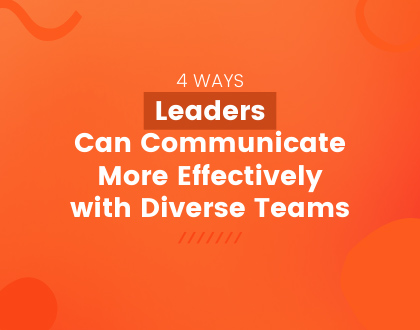
February 25, 2021
4 ways leaders can communicate more effectively with diverse teams
Over the past year, living and working in the midst of a pandemic, mourning the loss of many more Black lives to racism and anti-Blackness, and witnessing a violent insurrection on the U.S. Capitol, many of us have had to re-examine what it means to be an effective leader. In the face of unprecedented and compounding challenges, workplaces are more aware than ever of the importance of instilling inclusive communication skills within their organizations. Leaders, tasked with supporting and guiding people who hold a variety of social identities and personalities, bear an especial responsibility when it comes to communication and accounting for the diversity within their teams.
Through YW Boston’s inclusive leadership program, LeadBoston, participants gain the knowledge, skills, and network to practice leadership that advances diversity, equity, and inclusion (DEI) within their organizations. As part of the LeadBoston curriculum, participants explore and put into practice a variety of frameworks to strengthen their communication skills.
The LeadBoston Class of 2021 recently explored the relationship between social identities and leadership during their virtual Advance. The class spent time reflecting on the impact that social identities have on our daily workplace interactions. Each participant identified their own work styles when it comes to engaging in groups and how their approach may be impacting their interpersonal communications. They also considered strategies for communicating more inclusively.
Below are some key takeaways for leaders to communicate more effectively with diverse teams,
1. Understand how your social identities and communication style work together
Social identities inform how we experience life, including the workplace. At YW Boston, we define identity as “the way an individual thinks about themself, the way they are viewed by the world, and the characteristics that define them.” More specifically, social identities are a specific type of identity that are the “result of shared constructions and social relations” based on human-created societal norms (Johnson, 2006). Social identities include race, gender, age, ability, sexual orientation, religion, immigration status, class. What’s more, these identities intersect and create compounded advantages and disadvantages.
The exploration of social identities is invaluable for leaders, given that these identities not only impact how we are perceived by others but how we perceive ourselves. As one LeadBoston Class of 2021 participant put it during the February Advance, “A good leader acknowledges the identities of their team and the influence identity has on actions and behaviors.”
Communication and decision-making styles come into play during virtually every interaction in the workplace. Adaptations of the Merrill-Reid personality types framework describe four major categories:
- Analytical: Systematic and detail-oriented. Asks many questions and prefers a task-oriented work environment. Values accuracy.
- Driver: Likes control and takes action decisively. Prefers to work independently. Dislikes inaction. Focuses on the goal and end results.
- Amiable: Prioritizes personal relationships and is conflict-adverse. Good active listener and can garner support from others. Slow at making decisions.
- Expressive: Likes to take risks and innovate. Effective at inspiring others to follow a big-picture vision. Moves from one activity to another.
2. Beware of communication blockers such as the “stealth ‘but'”
“Yes, but…” is one of the most reliable ways of derailing conversations and leaving others feeling unheard. Stealth “buts” also include:
- “I understand where you’re coming from… However,”
- “I see your point… Nevertheless,”
- “That may be true… On the other hand,”
- “I know that may seem like the obvious solution… still,”
- “You could say that…only,”
- “You’re right…it’s just that,”
In order to combat the use of stealth “buts” and their derivatives, it’s important to begin building awareness around when these communication pitfalls come up and how often we use them. Once we become better at identifying them, we can put into practice different strategies to disrupt attitudes and phrases that undermine interpersonal rapport. When we challenge ourselves to use different language, we begin to notice when and how our implicit attitudes occur. Try shifting from “buts” to “builds” by building upon the person’s idea before adding your own thoughts or before asking a question. Your questions should reflect curiosity and interest, not a desire to persuade or “poke holes” in an argument. If you wish to state your disagreement with what someone says, do so explicitly and respectfully. (Conversation Transformation: Recognize and Overcome the 6 Most Destructive Communication Patterns, Benjamin, Yeager, & Simon)
3. Remove leading questions from your repertoire
When we ask leading questions, we’re not setting ourselves up to receive answers but rather to persuade others or suppress opposition. A leading question is a question and answer rolled into one and is often close-ended (i.e., can be answered by “yes” or “no”). Leading questions often:
- Start with “aren’t,” “don’t,” “isn’t,” “can’t,” “won’t,” or “wouldn’t”
- End with “wouldn’t you say?”, “isn’t it?”, “right?”
- Contains words like “really,” “truly,” “honestly”
As with any other habit, the first step to disrupting leading questions is to gain awareness of what they are, how often we use them, and what sort of situations bring them about. In order to avoid them, we must intentionally separate our own opinions from our questions. Focus on each aspect—the opinion and the question—and paraphrase them to check for understanding. Explore the concept of humble inquiries as a method of asking without telling.
4. Be cautious of mind-reading
Mindreading describes instances when we try to infer what other people are thinking without seeking clarification. Mindreading can cause us to form opinions or act upon assumptions. It is a significant barrier to effective communication as it can further entrench misunderstandings. Below are some signs that can help you identify if and when you are mindreading, so that you can disrupt the cycle:
- You spend more time imagining than having real conversations.
- You spend more time talking about others than to them.
- What you think others are not saying affects you most.
- You often wonder what others think of you.
- You think others aren’t telling the whole truth.
- Many things people say tend to bother you.
- Others often remind you of someone you know or once knew.
It’s essential for leaders to understand how social identities and the internalized and externalized assumptions that accompany them influence our communications. Only then can leaders and organizations be fully equipped to succeed in a vastly diverse workforce.
______
About LeadBoston
Become a part of YW Boston’s LeadBoston program and join a network of over 1,000 inclusive leaders in Greater Boston. During this 11-month program, participants explore and learn how to address barriers to inclusion through facilitated dialogue, expert speakers, and peer learning. Through experiential activities, participants delve into the social, political, and socioeconomic realities of Boston and explore innovative solutions to inequity. Interested in learning more? Reach out to Rachael McCoy, LeadBoston Manager, at rmccoy@ywboston.org with any questions about the program.


